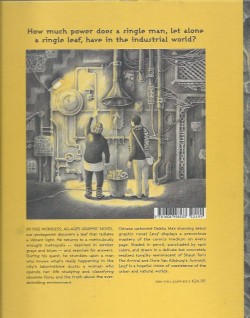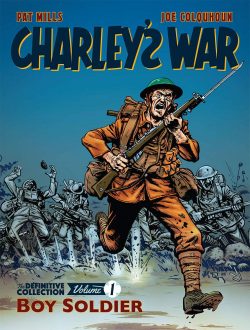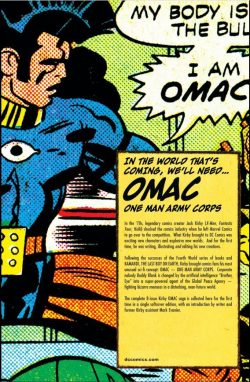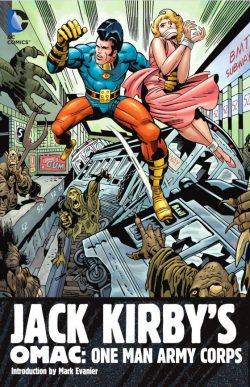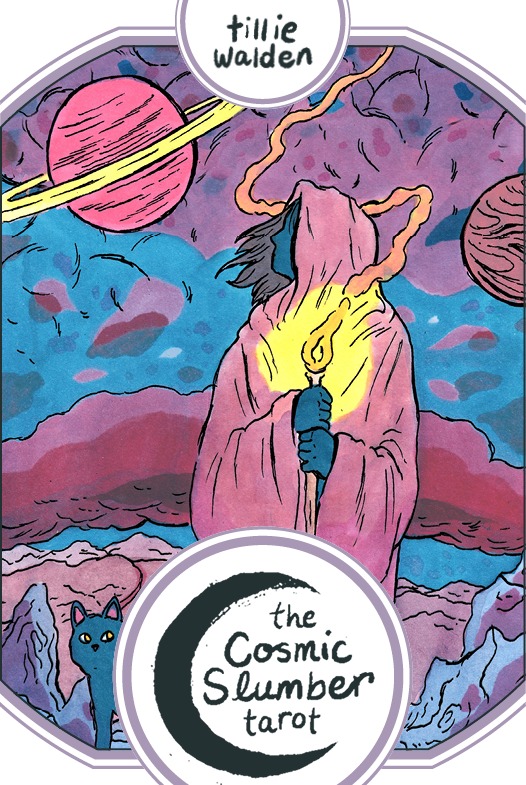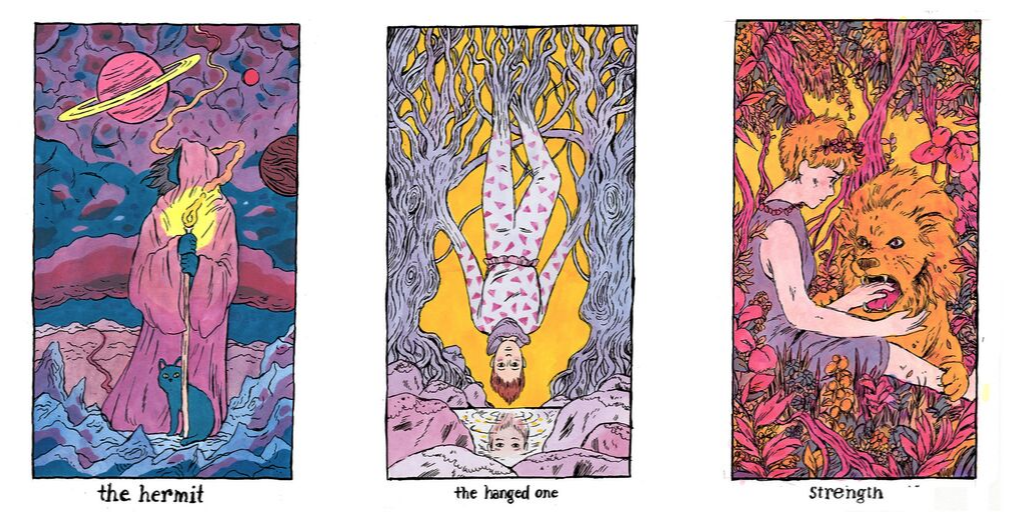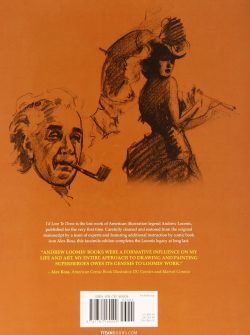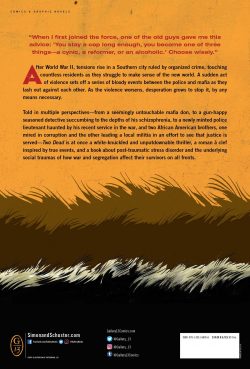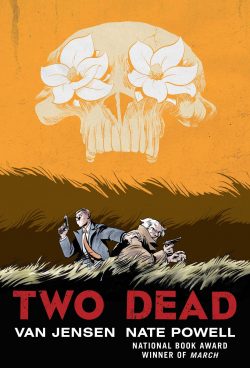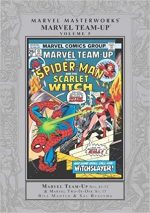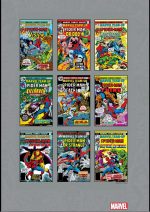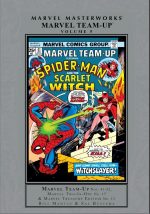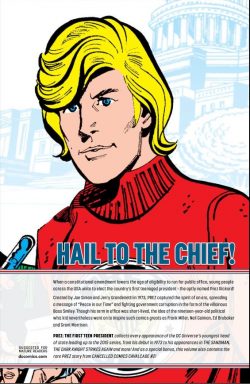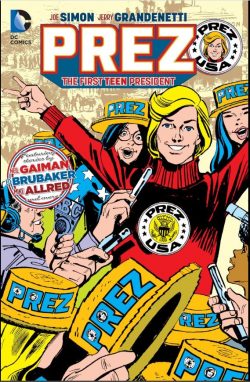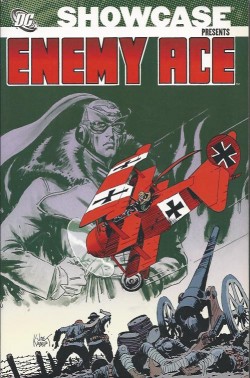
By Robert Kanigher, Joe Kubert, Dennis O’Neil, John Severin, Howard Chaykin, Frank Thorne, Ed Davis, Russ Heath, Neal Adams & various (DC Comics)
ISBN: 978-1-4012-1721-1 (TPB)
Same old story here. Brilliant, groundbreaking, unmissable, not available in any modern format or digitally. We never learn…
Enemy Ace first appeared as a back-up in DC’s flagship war comic Our Army at War: home of the instantly legendary Sergeant Rock. The tales, loosely based on “Red Baron†Manfred von Richthofen, were a magnificent and thought-provoking examination of and tribute to the profession of soldiering, whilst simultaneously condemning the madness of war. They were produced by the dream team of Robert Kanigher & Joe Kubert during a period when the ongoing Vietnam conflict was beginning to tear American society apart.
An immediate if seminal hit, the series told bitter tales of valour and honour from the point of view of German WWI fighter pilot Hans von Hammer: a hidebound but noble warrior fighting for his country in a conflict that was swiftly excising all trace of such outmoded concepts from the business of government sanctioned mass-killing.
Robert Kanigher (1915-2002) was one of the most distinctive authorial voices in American comics, blending rugged realism with fantastic fantasy in his signature war comics, as well as in horror stories, westerns and superhero titles such as Wonder Woman, Teen Titans, Hawkman, Metal Men, Batman plus other genres too numerous to cover here. A restlessly creative writer, he frequently used his uncanny but formulaic adventure arenas as a testing ground for future series concepts. Among the many epochal war features he created were Sgt. Rock, The War that Time Forgot, The Haunted Tank, The Losers and the controversial star of this stupendously compelling war-journal.
He sold his first stories and poetry in 1932, wrote for the theatre, film and radio, and joined the Fox Features shop where he created The Bouncer, Steel Sterling and The Web, whilst providing scripts for Blue Beetle and the original Captain Marvel.
In 1945 he settled at All-American Comics as both writer and editor, staying on when the company amalgamated with National Comics to become the forerunner of today’s DC. He wrote Flash and Hawkman, created Black Canary and many sexily memorable villainesses such as Harlequin and Rose and the Thorn. This last turbulent temptress he redesigned during the relevancy era of the early 1970s into a schizophrenic crime-busting vigilante who haunted the back of Superman’s Girlfriend Lois Lane, which Kanigher also scripted.
When the taste for mystery-men had faded at the end of the 1940s, Kanigher moved seamlessly into adventure yarns, westerns and war: becoming in 1952 writer/editor of the company’s combat titles.
As well as scripting for All-American War Stories, Star Spangled War Stories and Our Army at War, he created Our Fighting Forces in 1954 before adding G.I. Combat to his burgeoning portfolio when Quality Comics sold their line of titles to DC in 1956. This was whilst still working on Wonder Woman, Johnny Thunder, Rex the Wonder Dog, Silent Knight, Viking Prince and a host of others.
In 1956 he scripted ‘Mystery of the Human Thunderbolt’ – the first story of the Silver Age which introduced Barry Allenas the new Flash to the hero-hungry kids of the world. Drawn by Carmine Infantino, the risky experiment included multi-talented veteran Joe Kubert as inker for the crucially important debut issue…
Kubert was born in 1926 in rural Southeast Poland (which became Ukraine and might be Outer Russia by the time you read this). At age two his parents took him to America and he grew up in Brooklyn.
His folks encouraged Joe to draw from an early age and the precocious kid began a glittering career at the start of the Golden Age, before he was even a teenager. Working and learning at the Chesler comics packaging “Shopâ€, MLJ, Holyoke and assorted other outfits, he began his close association with National/DC in 1943, whilst still dividing his time and energies between Fiction House, Avon, Harvey and All-American Comics, where he particularly distinguished himself on The Flash and Hawkman.
In the early 1950s he and old school chum Norman Maurer were the creative force behind publishers St. Johns: creating evergreen caveman Tor and launching the 3D comics craze with Three Dimension Comics.
Joe never stopped freelancing, appearing in EC’s Two-Fisted Tales, Avon’s Strange Worlds, Lev Gleason Publications & Atlas Comics until in 1955 when, with the industry imploding, he took a permanent position at DC, only slightly diluted whilst he illustrated the contentious and controversial newspaper strip Tales of the Green Berets from 1965 to 1968.
An elder statesman of the industry, he was creating new works and passing on knowledge and experience through his world-famous Joe Kubert School until his death in August 2012.
This terrific monochrome tome re-presents the blockbusting exploits of Von Hammer from Our Army at War #151, 153, 155, Showcase #57-58, Star Spangled War Stories #138 -145, 147-150, 152, 158, 181-183, 200, Men of War #1-3, 8-10, 12-14, 19-20, The Unknown Soldier #251-253, 260-261, 265-267 plus an intriguing tribute from Detective Comics#404: a period spanning February 1965 to August 1982. The canon encompasses a period during which superheroes were supplanted by horror stories before bouncing right back again, whereas the genre of combat chronicles soldiered on regardless and largely unbothered by vagaries of reader fashion.
To be brutally frank, the stories are variations on the same theme and, despite being illustrated by many of the greatest artists of two generations, might feel a little samey. If so, just stop every now and then to cogitate a little. This isn’t a book to blaze through; it’s one to savour in sensible portions…
It all kicked off in the back of Our Army at War #151 (cover-dated February 1965), introducing the ‘Enemy Ace’ in a short, sharp shocker set in 1918 wherein celebrated aerial warrior Rittmeister von Hammer was hospitalised after downing a succession of Allied aircraft. The reserved stoic hero was simultaneously admired by comrades and nurses whilst being shunned and feared by them: they all inevitably came to characterise Germany’s greatest hero as cold and a “human killing machineâ€â€¦
Von Hammer took recuperative solace in hunting the wilds of the Schwartzwald, where he met a solitary black wolf who seemed to understand and share his lonely life of death and honour…
When his wounds were fully healed the dark knight returned to prowl once more “the Killer Skiesâ€â€¦
That 15-page yarn perfectly defined everything that could be said about the character, but the public could not get enough, so Von Hammer returned in #153 as ‘Flaming Bait!’ Dialled back to 1917 now (scripter Kanigher was never slavishly tied to tight or formal continuity), the cautionary tale featured the superstitious Rittmeister’s attempts to offset a wave of deaths which occurred each time a photographer took a pilot’s picture…
Our Army at War #155 (June 1965) featured ‘Fokker Fury!’, wherein the fanatically fair and scrupulous air ace accidentally shoots down an unarmed British fighter. After some excoriating self-castigation, Von Hammer reclaims his honour in a valiant display of mad bravado…
Mere months later, he starred in a brace of full-length thrillers for prestigious try-out vehicle Showcase. Issue #57 (July/August 1965) offered ‘Killer of the Skies!’: recapitulating all that had gone before whilst introducing a potential equal in the form of Canadian ace “The Hunterâ€.
A new wrinkle had also been added to the mix as Von Hammer now perpetually agonised and bemoaned his inability to save the human conveyor belt of naive, foolish replacement pilots to his Jagdstaffel from killing themselves through enthusiasm, bravado and youthful stupidity…
The following issue (#58, September/October) explored ‘The Hunters – and the Hunted!’, detailing how, after a blazing succession of kills, Von Hammer takes a recreational trip to his beloved Black Forest and renews acquaintance with his lupine companion. Here he has a brief encounter with a beautiful lady whose passion for the celebrity hero dies as she soon as apprehends his cold, seemingly emotionless executioner’s nature…
With all forms of human warmth clearly denied him, the Hammer of Hell reluctantly returns to the aerial killing fields…
Things went quiet after that as Enemy Ace clearly didn’t sell highly enough to garner its own continuing feature. Time passed and anti-war sentiment increasingly gripped the nation. In 1968 bimonthly war-mag Star Spangled War Stories – a title with a reputation for and history of offbeat material (Mlle. Marie, War that Time Forgot) – revived Von Hammer for a spectacular run of mesmerising tales which conclusively proved, time after time, that every War is Hell…
It began in #138 (April/May) with visually intoxicating epic ‘The Slayers and the Slain!’, debuting a French counterpart to the Teutonic Terror in the forbidding form of the masked and hooded, eerily anonymous Hangman.
This sombre sky-warrior flew a sinister coal-black Spad, throwing German pilots into a paralysing psychological funk, yet a conclusive duel with Von Hammer is postponed until the German recovers from yet another bout of wounds won in the Killer Skies…
With room to explore their timeless theme of a good man forced into wicked actions, SSWS #139 flashed back to the boyhood of the Air Ace in ‘Death Whispers… Death Screams!’ Here the austere life of a noble warrior is exposed; the manly pursuits of a Junker in training drummed into young Hans by his severe but loving father.
That grizzled old warrior, from a proud family of patriotic heroes, inculcates in the last of his line an overarching dedication to duty and honour above all other considerations: beliefs which carry him in his present endeavours though the shock of being humiliatingly shot down by the Hangman.
When they met again in the skies it is the Frenchman who crashes to earth, but he too survives to fly another day…
Also included here is a superb Kubert pictorial fact feature Battle Album: Fokker DR-1 and Spad S.13 to add to the already technically overwhelming ambiance…
In #140, the next clash of equals hideously reveals ‘The Face of the Hangman’, resulting in both men being marooned on the French side of the lines and becoming respectful intimates as Hammer heals in his rival’s chateau before the call of country and duty resulted in one final, fateful airborne showdown…
Inked by Frank Giacoia & Joe Giella, Star Spangled War Stories #141 takes a hard look at the men who fly beside Von Hammer. ‘The Bull’ is an ambitious new flier in the Jagdstaffel who endangers and even kills his own comrades in a pitiless quest for fame and glory. Before long, the Rittmeister has to take decisive and fatalistic action…
‘Vengeance is a Harpy!’ sees the impossible return of the Hangman, sowing death and terror amongst the German pilots, and forcing Von Hammer into a battle he does not want with a person he has come to admire, if not love…
In ‘The Devil’s General’ – after more time spent with the wolf in the woods – the brooding Rittmeister returns to duty, harrying ground troops and spectacularly eradicating opposition fliers. His composure is soon blighted by elderly General von Kleit, who forces his son Werner into the Squadron, expecting Von Hammer to keep the boy safe in the pitiless skies.
When the callow youth is shot down and captured, the Hammer of Hell moves Heaven and Earth to bring him back alive…
For #144, Kubert inked hot new penciller Neal Adams on ‘Death Takes No Holiday!’ as another macabre death-dealing French Ace – dressed as a skeleton – terrorises and slaughters the Jagdstaffel’s pilots, forcing the Enemy Ace into insane action to inspire his men and cure a young flier of fear-induced madness…
With Kubert back on solo art duties, SSWS #145 sees Von Hammer plagued by nightmares of his greatest opponent, as he attempts to school a trio of veteran pilots for the inevitable day when one would replace him. However, the actual ‘Return of the Hangman’ shatters those plans forever…
Another baroque opponent surfaces in #147 as an obsessive English lunatic believing himself St. George dons a suit of armour to shoot down far too many of the Rittmeister’s pilots. It’s all part of a scheme to give the infallible Hammer of Hell ‘A Grave in the Sky!’ However, this particular vendetta concludes on the ground with ancient swords drawn…
Kanigher was never above using wrenching melodrama and sheer sentimentality to his advantage. The moving saga in #148 describes how a little puppy becomes a mascot for solitary, isolated Von Hammer, but the cute little tyke’s inescapable horrific ending is just another hammer-blow of heartbreak in ‘Luck is a Puppy named Schatzi!’
Despite immense critical acclaim, the series dwindled in popularity. Star Spangled War Stories 149 (February/March 1970) saw the Viking Prince join the eclectic comic’s line up with Enemy Ace reduced to 15 pages. ‘Reach for the Heavens’ – inked by Sid Greene – finds Von Hammer again meeting hated flying school rival Heinrich Müller: a complex sadistic killer who redeems himself after committing war crimes in a tale tinged with supernatural overtones…
The run truly ended with #150 and ‘3 Graves to Home!’, as the Enemy Ace is shot down over rural France and must fight his way back to his own lines. He encounters a succession of civilians all putting a human face on the war he usually fought so far above them, but his time in the sun was almost over…
With Star Spangled War Stories #151(June/July 1970), a new feature took over the lead spot, running until the magazine changed its name with the 204th (February 1977) issue to reflect the newcomer’s popularity. As The Unknown Soldier, it continued for a further 64 episodes until it too died with #268 (October 1982).
Star Spangled War Stories #152, however, offered one more uncompromising mission from which only the Hammer of Hell returned. ‘Rain Above… Mud Below!’, illustrated by Russ Heath, was supplemented by another informative Kubert Battle Album starring the Lafayette Escadrille…
Although gone, the iconic German warrior was far from forgotten. SSWS #158 featured a stunning Kubert ‘Special Pin-up: Enemy Ace – the Hammer of Hell’ whilst issue #181-183 held a compelling 3-part back-up serial by Kanigher & Frank Thorne which pitted the noble intellectual against maverick American Ace Steve Savage – “The Balloon Buster†in ‘Hell’s Angels Part One: The Hammer of Hell!’, ‘Hell’s Angels Part Two: The Maverick Ace!’ and the savage but inconclusive finale ‘Hell’s Angels Part Three: To End in Flames!’(June/July to November/December 1974)…
Von Hammer resurfaced in the anniversary Star Spangled War Stories #200 (June/July 1976). ‘Shooting Star’ was written and drawn by Kubert, as a German innovation in rocket-propelled aircraft catastrophically proves to be an invention whose time had not yet come…
A new anthology comic book debuted in August 1977. Men of War starred Gravedigger, a black American GI in WWII, but had alternating back-ups. Enemy Ace copped the first slot in issues #1-3 (by Kanigher, Ed Davis & Juan Ortiz) as ‘Death is a Wild Beast!’ saw Von Hammer down a devil-themed British pilot who accomplished a miraculous ‘Return from Hell!’ before exhibiting ‘The Three Faces of Death’ in the final instalment. As ever, the real meat of the macabre missions was the toll on the minds and bodies of the merely mortal fliers that died whilst Von Hammer lived on…
Another triptych featured in #8-10. ‘Silent Sky… Screaming Death!!’ – illustrated by Larry Hama & Bob Smith – began a trenchant tale of a family at war before Howard Chaykin took over the illustration with a duel in the sky resulting in an attack by vengeful siblings and the return of Von Hammer’s father in ‘Brother Killers!’, before ending in a fateful ‘Duel at Dawn!’
Men of War #12-14 offered more of the same as ‘Banner of Blood!’ saw the troubled Rittmeister strive to retrieve the Von Hammer family flag from a cunning French air ace who was an ancestral foe of ‘The Last Baron!’ The centuries-long vendetta with the Comtes de Burgundy finally ended in one last honourable ‘Duel!’
Issues #19-20 (August and September 1979) finished another run with one more tale of idiotic honour and wasted young lives as Von Hammer made ‘A Promise to the Dying’ and sought to return a contentious souvenir to its rightful owner in ‘Death Must Wait!’
In the May 1981 Unknown Soldier – #251 – Enemy Ace began an occasional series of adventures illustrated by the phenomenal John Severin.
First was ‘Hell in the Heavens Part One: I, the Executioner’ wherein Von Hammer’s whirlwind romance with Fraulein Ingrid Thiesse hit a bump after he told of the British boy pilot who died in his arms. Having sworn to find his valiant foe’s sister and return an heirloom, Hans soon found himself under attack in #252’s ‘Hell in the Heavens Part Two: The Midnight Spy’, before shocking answers were manifest in the concluding ‘Hell in the Heavens Part Three: Midnight and Murder’…
A far more imaginative yarn unfolded in #260 (February 1982) with ‘I Am My Own Executioner Part One: Stolen Face – Stolen Ace!’ when the German High Command brings in a doppelganger to replace national hero Von Hammer as he recovers from wounds. Sadly, the impostor was not only a sadistic butcher but crazy as a loon and the real deal had to defy his doctors and military superiors before shooting the maniac out of the skies – for the sake of the country and his own besmirched good name – in #261’s ‘I Am My Own Executioner Part Two: Death of a Double!’…
The last flight of the war-weary warrior came in Unknown Soldier #265-267 (July through September 1982) as the British Government puts a huge price on Von Hammer’s head in ‘A Very Private Hell Part One: The Bounty Hunters!’
The resultant furore leads to a return engagement for Yankee white trash Steve Savage in ‘A Very Private Hell Part Two: The Substitute Ace’ and the death of a brave but foolhardy fake ace before the drama ends – again inconclusively – in ‘A Very Private Hell Part Three: Debt of Blood’…
Although the grim conflicts of the chivalrous cavalry of the clouds conclude here, this epic tome holds one last treat in reserve: an outré but definitively classy tribute to the Hammer of Hell which originally appeared Detective Comics #404 (October 1970). Crafted by Denny O’Neil, Neal Adams & Dick Giordano, ‘Ghost of the Killer Skies!’ sees Batman attempting to solve a series of impossible murders on the set of a film about the German WWI fighter ace.
All evidence seems to prove that the killer can only be a vengeful phantom, but in the killer skies over Central Spain the Dark Detective uncovers almost incontrovertible evidence of a malign human intelligence behind the deaths.
…Almost incontrovertible…
These often bizarre, always moving and utterly unforgettable stories celebrate a true high point in the annals of combat comics: crafted by masters of the art form who never failed to ram home the point that war is not a profession for anybody who enjoys it, and that only the lucky, the mad and the already-doomed have any chance of getting out at all…
© 1965, 1968, 1969, 1970, 1971, 1974, 1976, 1977, 1978, 1979, 1981, 1982, 2008 DC Comics All Rights Reserved.
